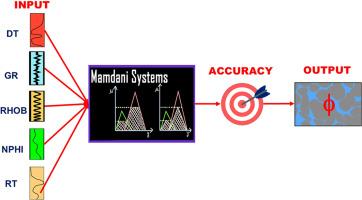利用基本测井资料、岩心样品测量和模糊逻辑方法估算巴西东南部Albian碳酸盐岩储层的孔隙度
IF 1.5
4区 地球科学
Q3 GEOSCIENCES, MULTIDISCIPLINARY
引用次数: 0
摘要
这项研究是在巴西东南部的一个碳酸盐岩储层中进行的,该储层由Quissamã组的钙砾岩组成,这是一个重要的区域含油储量。常规测井数据,包括自然伽马、体积密度、中子孔隙度、深部电阻率、声波或传输时间测井,作为输入。通过采用模糊逻辑的人工智能方法估算孔隙度,并根据岩心样本值(考虑有效孔隙度)验证这些结果的精度。选择的推理系统是Mamdani技术,它使用模糊集将输入与输出关联起来。选择三角隶属函数和建立支持模型的模糊规则是关键。取得的成果被认为是有希望的;然而,重要的是要记住模糊逻辑模型,像任何估计方法一样,可能容易受到不确定性的影响。结果表明,利用单个测井曲线进行孔隙度推断可以获得最佳的声波测井结果,Pearson相关系数为0.75,最小绝对误差为2.8,Willmott一致指数为0.24。该测井主要属于原生孔隙度,表明只有在这种情况下,估算才有效。声波测井和伽马测井的最优组合分别为0.78、2.71和0.40。这一估计超过了之前的估计,因为声波测井与伽马测井一起显示,尽管它与降低的孔隙度有关,因为它量化了粘土或碳酸盐泥浆的存在。三种测井曲线的最佳组合为声波、密度和中子,其值分别为0.74、2.95和0.37。这一估计与前两种估计一致,因为声波测井与原生孔隙度有关,而密度和中子测井更多地与总孔隙度有关。使用四种测井曲线(声波、伽马、密度和中子)的结果分别为0.72、2.94和0.42。这一估计与以前的估计相当,但在该组中是否包含伽马射线测井仍然存在不确定性。利用所有五个对数得到的结果是0.51、3.71和- 0.47,这构成了一个不令人满意的估计。这可以通过结合电阻率测井来解释,电阻率测井与岩石孔隙中所含的流体更相关。结果表明,声波测井和伽马测井相结合可获得最准确的孔隙度估算结果。声波测井出现在所有的估计中,但电阻率测井只包括在最后的估计中。随着Pearson相关系数的减小,最小绝对误差增加,而Willmott协议指数则显示出变异性。这种评估孔隙度的方法得出的结论是,所有的估计都应该被考虑在一个准确的评估中,并且测井可以与人工智能技术相结合,以精确地确定未取心井的孔隙度。本文章由计算机程序翻译,如有差异,请以英文原文为准。

Porosity estimates in an Albian carbonate reservoir in southeastern Brazil using basic well logs, core sample measurements, and fuzzy logic approach
This study was performed in a carbonate reservoir located in southeastern Brazil, comprising calcarenites from the Quissamã Formation, which are significant regional oil-bearing reserves. Conventional well logs, including natural gamma ray, bulk density, neutron porosity, deep resistivity, and sonic or transit time logs, were utilized as input. Porosity estimates were produced via an artificial intelligence methodology employing fuzzy logic, and the precision of these results was verified against core sample values, considered effective porosity. The selected inference system was the Mamdani technique, which uses fuzzy sets to correlate inputs with outputs. The selected triangular membership functions and the established fuzzy rules that support the models are essential. The results achieved are considered promising; however, it is important to remember that fuzzy logic models, like any estimation method, may be susceptible to uncertainties. The results indicate that utilizing individual logs for porosity inference yields optimal outcomes with the sonic log, exhibiting a Pearson correlation coefficient of 0.75, a minimal absolute error of 2.8, and a Willmott agreement index of 0.24. This log mostly pertains to primary porosity, indicating that the estimation is only valid under these circumstances. The optimal combination for the pairings was the sonic and gamma ray logs yielding values of 0.78, 2.71, and 0.40. This estimate surpasses the prior one, as the sonic log is shown in conjunction with the gamma ray log, despite being linked to reduced porosity, since it quantifies the presence of clay or carbonate mud. The optimal combination of the three logs was sonic, density, and neutron, with values of 0.74, 2.95, and 0.37, respectively. This estimate coincides with the preceding two, as the sonic log is associated with primary porosity, while the density and neutron logs pertain more to total porosity. Using four logs: acoustic, gamma ray, density, and neutron logs produced values of 0.72, 2.94, and 0.42 using four logs. This estimate is comparable to previous ones, while there remains uncertainty on the inclusion of the gamma ray log in the group. The results obtained from utilizing all five logs are 0.51, 3.71, and −0.47, which constitutes an unsatisfactory estimate. This can be explained by the incorporation of the resistivity log, which is more related to the fluids contained within the rock's pores. The results indicate that the most accurate porosity estimate was achieved through the integration of acoustic and gamma ray logs. The acoustic log is present in all estimates, but the resistivity log is included only in the final one. As the Pearson correlation coefficient diminishes, the minimum absolute error increases, while the Willmott agreement index reveals variability. This method of assessing porosity led to the conclusion that all estimates should be considered in an accurate evaluation and that the logs can be applied with artificial intelligence techniques to precisely determine porosity in uncored boreholes.
求助全文
通过发布文献求助,成功后即可免费获取论文全文。
去求助
来源期刊

Journal of South American Earth Sciences
地学-地球科学综合
CiteScore
3.70
自引率
22.20%
发文量
364
审稿时长
6-12 weeks
期刊介绍:
Papers must have a regional appeal and should present work of more than local significance. Research papers dealing with the regional geology of South American cratons and mobile belts, within the following research fields:
-Economic geology, metallogenesis and hydrocarbon genesis and reservoirs.
-Geophysics, geochemistry, volcanology, igneous and metamorphic petrology.
-Tectonics, neo- and seismotectonics and geodynamic modeling.
-Geomorphology, geological hazards, environmental geology, climate change in America and Antarctica, and soil research.
-Stratigraphy, sedimentology, structure and basin evolution.
-Paleontology, paleoecology, paleoclimatology and Quaternary geology.
New developments in already established regional projects and new initiatives dealing with the geology of the continent will be summarized and presented on a regular basis. Short notes, discussions, book reviews and conference and workshop reports will also be included when relevant.
 求助内容:
求助内容: 应助结果提醒方式:
应助结果提醒方式:


